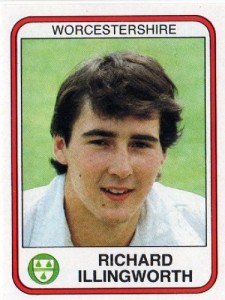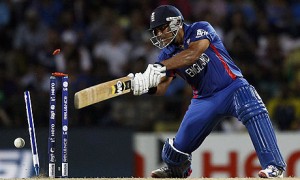
A gradual but inevitable descent into cricket-based loathing and bile.
Whatever Happened To The Unlikely Lads? #50: Richard Illingworth
Amidst all the recent gnashing and wailing of teeth about just how dismally shit England are at limited overs cricket, there have been a number of people questioning whether they’ve actually ever been any good. The answer is, of course, yes: they were pretty good at the 1992 World Cup, when they reached the final before losing to Pakistan (although they did manage to lose to Zimbabwe along the way). This represents the very outer limits of the 51allout memory, happening back before any of us were teenagers, and before some of us were even born. Probably: the 51allout HR department’s record keeping is notoriously lax, which probably explains why no-one seems to have any records of our bank accounts.
One of the stars of that last good England side still regularly turns up on our TV these days, albeit it in his current role as a leading international umpire, where his main job is finding ways to make sure that stuff Devereux does is always considered within the rules. The man we are referring to is, of course…
#50: Richard Kenneth Illingworth
That England team of the early 90s wasn’t a great side by any means, but it had a lot going for it. Foremost in that list of assets were three of the great moustaches: those belonging to Graham Gooch, Robin Smith and our titular hero. The combination of that moustache and a vaguely upper-class surname that harks back to an earlier age (when Britain could perhaps truly be called Great and the Scottish weren’t desperately trying to get away) gave our hero the look of a fighter pilot who turned his hand to cricket after the war. At least that’s what a young 51allout thought – and the same young 51allout was also convinced he was the son of Raymond in the same way Bobby Robson was Bryan’s dad. It turns out he was actually born in Bradford in 1963 and as far as records show, there’s not an ounce of Raymond’s DNA in him. Which is fortunate as Ray Illingworth’s DNA is in turn shared with Satan’s.
As a cricketer Illingworth embodied the no nonsense, stiff upper lip, English tea-drinking style of the time. He was a left-arm spinner who didn’t particularly turn or flight the ball, instead relying on metronomic accuracy and a buildup of pressure. He could also bat a bit, as four first-class centuries can testify. Worthy he certainly was, but exciting he was not. Apart from when he took a wicket with his first ball in Test cricket, bowling Phil Simmons with one that, to no-one’s great surprise, didn’t actually do much.
Perhaps the best way to describe Illingworth is as the James Tredwell of his day. We don’t mean that as an insult – we love Tredders like a slightly creepy uncle – but instead as a testament to Illingworth’s reliability, calm under pressure and general ability to just be a bit sensible. Although this being England, it wasn’t a simple question of deciding on the tactics and picking a spinner to fit them. Instead there was an on/off selection battle with England’s enfant terrible Phil Tufnell, he of the basic fielding skills deficiency:
Over the course of their respective careers, it soon became clear that, despite all his faults, Tufnell was more often the selectors’ spinner of choice in the longer form of the game. Illingworth played just nine Tests (six of them against the West Indies at home), taking 19 wickets at 32, far from terrible numbers. Conversely, Tufnell played 42 Tests and took 121 wickets, albeit at a higher average of 38. And yet in limited overs cricket, neither truly made any sort of impression, making just 20 and 25 appearances respectively. To put that into terrifying perspective, that’s fewer than both Ian Blackwell (34 matches) and Jamie Dalrymple (27).
What’s clear from those statistics is that England have almost never had a proper plan for their spinner(s) in one-day cricket. Only Graeme Swann in recent years has been able to offer both control and a wicket-taking threat in the middle overs. Other than that England have been utterly clueless, trying to stumble upon a genuine limited overs spin option for more than two decades. The likes of Ashley Giles and Robert Croft did a job for a while, despite having averages in the high thirties. Even Samit Patel has managed 36 matches, despite being little more than a club bowler with a weight problem.
Illingworth’s playing career may have been fairly mediocre but he certainly seems to be a pretty decent umpire. Having said that, comparing him with the likes of Bruce Oxenford is like comparing good cheese with shit chalk. And as with any kind of comparison that doesn’t involve females, it’s the person with the best ‘tache that always comes out on top.



No Comments
Post a Comment